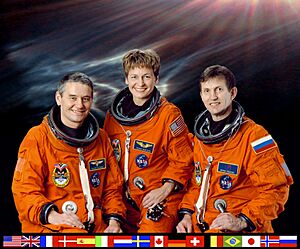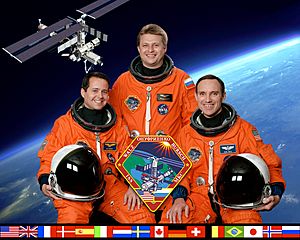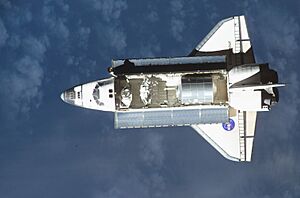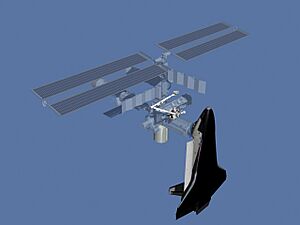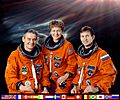STS-111 facts for kids
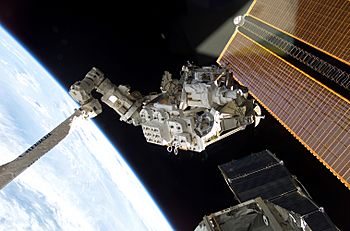
Canadarm2 grapples the Mobile Base System, prior to its installation on the ISS' Mobile Servicing System
|
|
| Mission type | ISS logistics Crew rotation |
|---|---|
| Operator | NASA |
| Mission duration | 13 days, 20 hours, 35 minutes, 56 seconds |
| Distance travelled | 9,300,000 kilometres (5,800,000 mi) |
| Spacecraft properties | |
| Spacecraft | Space Shuttle Endeavour |
| Launch mass | 116,523 kilograms (256,889 lb) |
| Landing mass | 99,385 kilograms (219,106 lb) |
| Payload mass | 12,058 kilograms (26,583 lb) |
| Crew | |
| Crew size | 7 |
| Members |
|
| Launching |
|
| Landing |
|
| Start of mission | |
| Launch date | 5 June 2002 21:22:49 UTC |
| Launch site | Kennedy LC-39A |
| End of mission | |
| Landing date | 19 June 2002 17:58:45 UTC |
| Landing site | Edwards Runway 22 |
| Orbital parameters | |
| Reference system | Geocentric |
| Regime | Low Earth |
| Perigee | 349 kilometres (217 mi) |
| Apogee | 387 kilometres (240 mi) |
| Inclination | 51.6 degrees |
| Period | 91.9 minutes |
| Docking with ISS | |
| Docking port | PMA-2 (Destiny forward) |
| Docking date | 7 June 2002 16:25 UTC |
| Undocking date | 15 June 2002 14:32 UTC |
| Time docked | 7 days, 22 hours, 7 minutes |
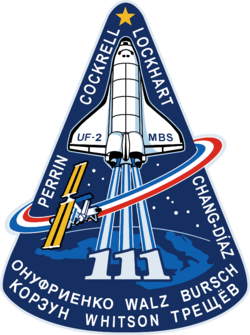 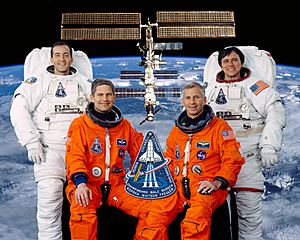 (L-R): Philippe Perrin, Paul S. Lockhart, Kenneth D. Cockrell, Franklin R. Chang-Diaz |
|
STS-111 was an exciting space shuttle mission to the International Space Station (ISS). The mission was flown by Space Shuttle Endeavour. Its main jobs were to deliver new supplies to the station and to swap out the astronauts living there. The Expedition 4 crew returned to Earth, and the Expedition 5 crew began their stay. This important mission launched on June 5, 2002, from Kennedy Space Center in Florida.
Contents
Meet the Astronauts: STS-111 Crew
The STS-111 mission had a crew of seven astronauts. Four of them were part of the shuttle crew, and three were the new team for the International Space Station. The mission also brought back the three astronauts who had been living on the station.
| Position | Launching Astronaut | Landing Astronaut |
|---|---|---|
| Commander | Fifth and last spaceflight |
|
| Pilot | First spaceflight |
|
| Mission Specialist 1 | Only spaceflight |
|
| Mission Specialist 2 | Seventh and last spaceflight |
|
| Mission Specialist 3 | Expedition 5 Second and last spaceflight ISS Commander/Soyuz Commander |
Expedition 4 Second spaceflight ISS Commander/Soyuz Commander |
| Mission Specialist 4 | Expedition 5 First spaceflight ISS Flight Engineer |
Expedition 4 Fourth and last spaceflight ISS Flight Engineer |
| Mission Specialist 5 | Expedition 5 Only spaceflight ISS Flight Engineer |
Expedition 4 Fourth and last spaceflight ISS Flight Engineer |
What Did STS-111 Do?
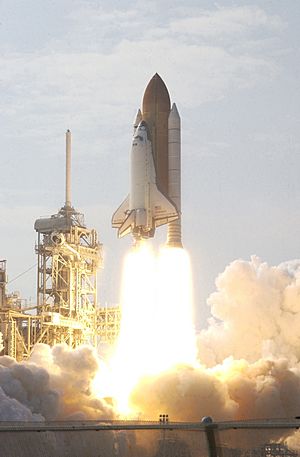
STS-111 was a very busy mission! Besides bringing fresh supplies, it was crucial for changing the crews on the International Space Station. The three astronauts from Expedition 4 (one Russian, two American) were replaced by the three new Expedition 5 members (two Russian, one American).
The shuttle also carried a special cargo container called the Multi-Purpose Logistics Module (MPLM). This module was packed with experiment equipment and storage racks for the station.
A major task was installing a new part for the Canadarm2, which is the space station's robotic arm. This new part was called the Mobile Base System (MBS). It was attached to another piece, the Mobile Transporter (MT), which had been installed on an earlier mission (STS-110). The MBS allowed the robotic arm to move along the station's truss (the main structure) to reach different work areas. This made the arm much more flexible!
STS-111 was also special because it was the last flight for an astronaut from the French space agency, CNES. After this mission, their astronauts joined the ESA.
Spacewalks: Working Outside the ISS
During the STS-111 mission, astronauts performed three spacewalks, also known as Extravehicular Activities (EVAs). These spacewalks were essential for installing new equipment and making repairs on the International Space Station.
| Mission | Spacewalkers | Start – UTC | End – UTC | Duration | What They Did |
|---|---|---|---|---|---|
| STS-111 EVA 1 |
Franklin R. Chang-Diaz Philippe Perrin |
9 June 2002 15:27 |
9 June 2002 22:41 |
7 h, 14 min | Attached a power and data connector to the P6 Truss. |
| STS-111 EVA 2 |
Franklin R. Chang-Diaz Philippe Perrin |
11 June 2002 15:20 |
11 June 2002 20:20 |
5 h, 00 min | Attached the Mobile Base System to the Mobile Transporter. |
| STS-111 EVA 3 |
Franklin R. Chang-Diaz Philippe Perrin |
13 June 2002 15:16 |
13 June 2002 22:33 |
7 h, 17 min | Replaced a part of the Canadarm2 robotic arm called the wrist joint. |
Launch Attempts: Getting Ready for Space
Before a space shuttle can launch, everything has to be perfect. Sometimes, missions are delayed due to weather or technical issues. Here's how STS-111's launch attempts went:
| Attempt | Planned | Result | Turnaround | Reason | Decision point | Weather go (%) | Notes |
|---|---|---|---|---|---|---|---|
| 1 | 30 May 2002, 7:44:26 pm | scrubbed | — | weather | thunderstorms and electrical activity | ||
| 2 | 31 May 2002, 7:21:52 pm | scrubbed | 0 days, 23 hours, 37 minutes | weather | delayed due to concerns about bad weather, including hail | ||
| 3 | 5 Jun 2002, 5:22:48 am | success | 4 days, 10 hours, 1 minute | earlier plans for a Monday launch were delayed because of problems with a nitrogen valve |
Images for kids
See also
 In Spanish: STS-111 para niños
In Spanish: STS-111 para niños


